3 Days in Rome: The Perfect Rome Itinerary for First-Timers
I’m going to be completely honest with you – 3 days in Rome is not enough.
The Italian capital city is massive, with such a rich history and so many impressive sights that you could spend a month in Rome and still only scratch the surface.
Even the most Type A travellers will not be able to see everything in Rome in 3 days, but with careful planning, it is certainly possible to visit all of the major Rome attractions (and eat a lot of delicious Roman food), in a long weekend.
And how do I know?
Well, I just spent 3 days in Rome last weekend on a Jet2CityBreak.
For those of you who don’t know, Jet2CityBreaks combine the cost of flights and accommodation to get you a great deal, whether you’re looking for a summer excursion or a winter escape.
The cost of my flights (including a 10 KG cabin bag and 22 KG checked-in luggage) and 3 nights in a swanky 4-star hotel was less than 400 GBP which is honestly a steal.
Although I didn’t get to see everything I wanted to see in Rome during this short time, I did manage to squeeze in a fair amount, and now I know how my 3 day Rome itinerary could have improved, I decided to use my experiences to create a better one, just for you.
3 Days in Rome: The Perfect Rome Itinerary for First-Timers
Rome at a glance
Rome is a big city that attracts a lot of tourists, and if you want a successful trip, you’ll need to plan it well.
In fairness, any trip to Italy takes a bit of planning, if not an awareness of the weird and wonderful things that you can expect when you visit Italy.
If you’re visiting Rome in the winter like I did, you won’t have to book very far in advance (you can even book on the same day sometimes!), but if you plan on visiting Rome in high season, I recommend booking things as early as you can, and always opting for the ‘Skip The Line’ package.
Doing this will save you hours of waiting in line in the blistering heat, or being disappointed when you turn up to see something and discover that it’s closed for the day.
Now, while there is no one-size-fits-all approach to visiting Rome, there are definitely things that most people want to see when they visit the Eternal City.
In order to see as many of those things as possible, I recommend sticking to the following schedule:
Day 1 – The Historical Centre
Day 2 – Ancient Rome
Day 3 – The Vatican
This will prevent you from wasting valuable time criss-crossing the city, allowing you to see things located nearby one another (and saving your precious feet!).
If you’re spending the weekend in Rome, you may want to switch around the second and third day of this itinerary, because the Vatican is closed on Sundays (aside from the last Sunday of every month).
3 days in Rome itinerary
Day 1 | Centro Storico – Piazza Navona, Trevi Fountain, Spanish Steps, The Pantheon, Campo de’ Fiori, Piazza Venezia
Kick off your first day in Rome with a traditional Italian breakfast.
Breakfast in Italy is a simple affair designed to give you a sugar rush and a caffeine hit to get you ready and raring to go.
Head to a bar or pasticceria and take your pick from the freshly-baked sweet pastries on offer, ordering an espresso or frothy cappuccino to drink alongside it.
Cornetti are the one of the most common choices for Romans at breakfast time.
A cornetto is like a croissant but sweeter, and you can buy them plain or filled with jam, custard, or Nutella.
For a great coffee and cornetto, head to Sant’ Eustachio il Caffè. This place serves some of the best coffee in Rome, and if you like, you can queue up with the locals and buy a bag to take home with you!
Dolce Rotunda is another great choice.
Pro tip: it usually costs more to sit down at a café in Italy, which is why you’ll only ever see locals standing at the bar with their pastries.
This isn’t a scam or tourist trap – it’s something known as a coperto, which is essentially a table/service charge. Technically, coperto is banned in the region of Lazio, where Rome is located, but in practice, you will still find restaurants and cafes charging coperto.
When you’ve finished, it’s time to start discovering Rome!
Piazza Navona
Piazza Navona is one of the most famous and beautiful piazzas in Rome.
It was built on what was once a stadium in Ancient Rome, and has been a designated public space since the 15th century.
Piazza Navona is home to stunning Baroque architecture and 3 intricate fountains.
The central fountain is called the Fontana dei Quattro Fiumi (Fountain of the Four Rivers) by Bernini, and you should spend some time admiring the various sculptures that it is comprised of.
Top tip: Most of the restaurants on Piazza Navona are expensive tourist traps which you’d do well to avoid.
Trevi Fountain
Trevi Fountain is one of the most famous landmarks in Rome, and is always incredibly crowded.
Even in January, when the streets of Rome are much quieter, you will still find large crowds at Trevi.
With that being said, you can’t go to Rome and not see it, and it is certainly a beautiful sight.
The Trevi Fountain was built over a period of 130 years, and is the largest Baroque fountain in Rome.
A popular tradition when you visit the Trevi Fountain is to throw a coin over your left shoulder with your right hand.
Legend has it that tossing 1 coin means you’ll come back to Rome, 2 coins means you’ll fall for an attractive Italian while you’re there, and 3 coins means you’ll marry them in the Eternal City!
Whether or not you believe in legends, the coins go to a good cause – they collect around a million euros every year and give it to local charities.
Top tips: Restaurants and cafes around Trevi are tourist traps that you should avoid. You should also come to Trevi Fountain very early in the morning if you want to avoid the worst of the crowds.
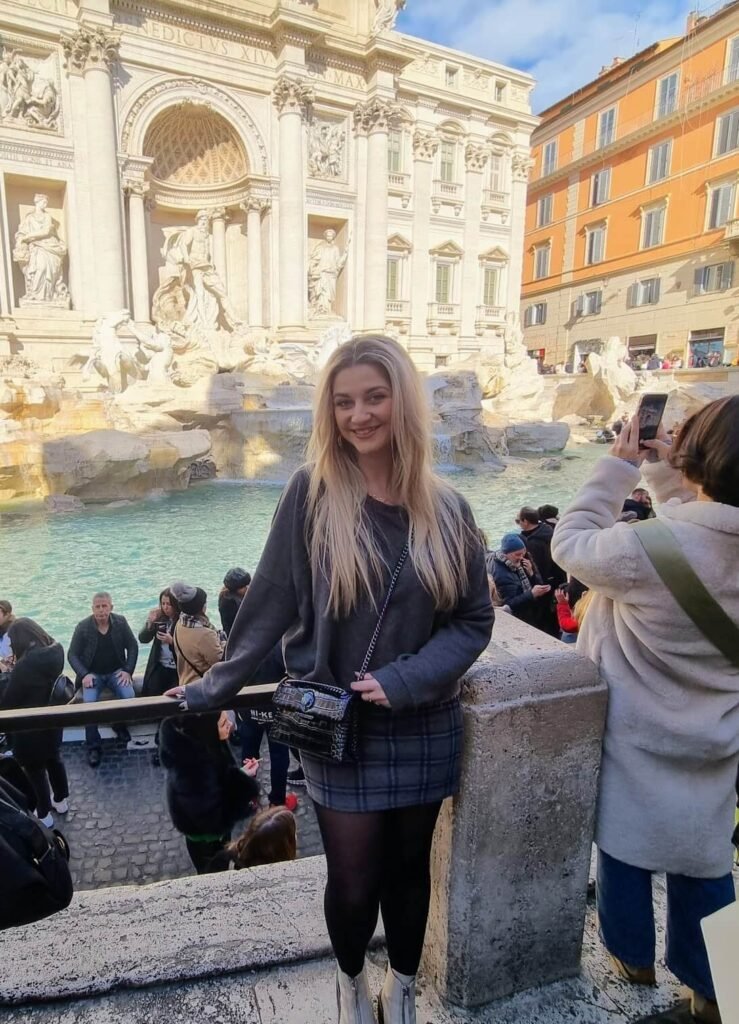
Spanish Steps
Another of the most famous landmarks in Rome is the Spanish Steps.
The Spanish Steps are a 135-step staircase that were made extra popular in the Audrey Hepburn film, Roman Holiday.
At the bottom is a Baroque fountain named Fontana della Barcaccia (Fountain of the Leaky Boat), and while most bloggers say that the Spanish Steps are the perfect place to ‘soak up the atmosphere of Rome,’ you’d be really hard-pressed to find any locals here
I may get cancelled for saying this, but if you ask me, the Spanish Steps are not one of the most exciting things to see in Rome.
Top tip: Don’t sit on the steps! Since 2019, you can be fined for sitting on the Spanish Steps as they are classified as a monument.
The Pantheon
The Pantheon is another of Rome’s most famous attractions, and you only have to see it from the outside to understand why.
Not only are its imposing columns incredibly striking, but its dome is the largest unreinforced dome in the world!
Built by the emperor Hadrian between 126 – 128 AD, The Pantheon was originally built to worship the Roman Gods, but was turned into a Catholic Church in the 7th century.
Important Italian figures are buried here (such as Vittorio Emanuele, first King of Italy), and it functions as a church to the present day.
Pro tip: entry to The Pantheon is free, but if you’re visiting on Saturdays, Sundays, or Italian public holidays, you must book your visit in advance.
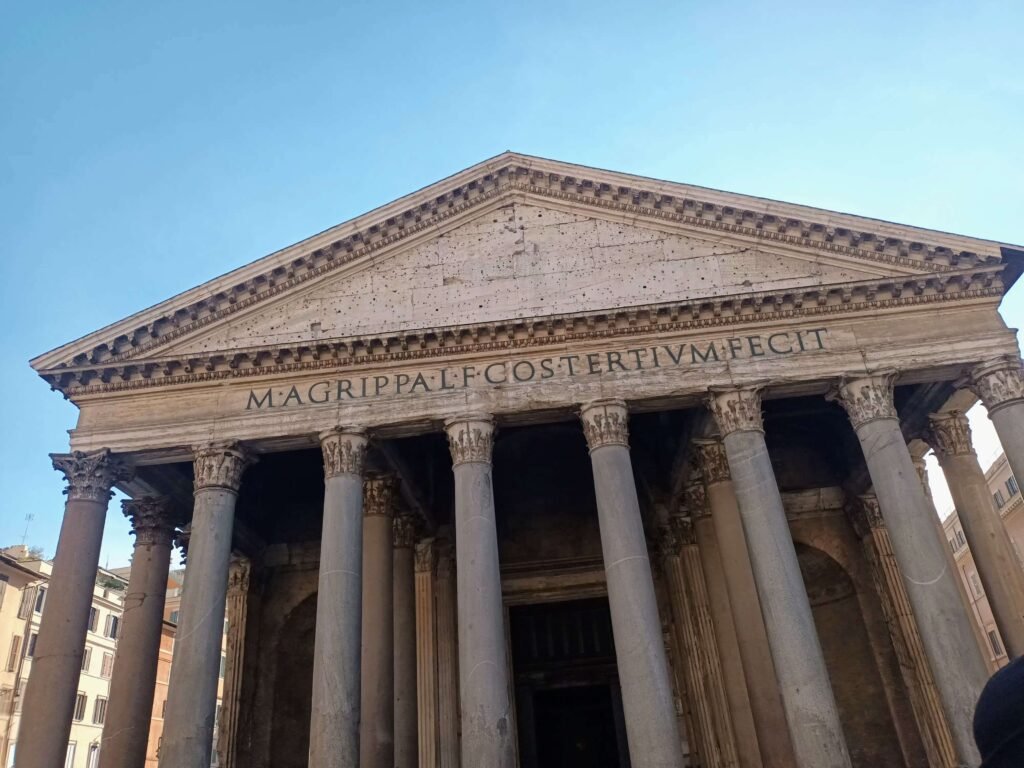
Lunch at Miscellanea
By now, you’re probably feeling a bit peckish, and luckily enough, there’s a great trattoria close to The Pantheon where you can enjoy a quick lunch.
Miscellanea is a self-proclaimed ‘international students pub,’ but if you can get past the photos of Donald Trump on the walls, what you’ll actually find is a cosy and old-fashioned space where you can enjoy reasonably-priced Roman classics.
Ethan and I opted for spaghetti cacio e pepe (spaghetti with sheep cheese and black pepper) and lasagne al ragu, and together with wine, bread, fruit and a digestivo shot, the total bill came to just 34 EUR.
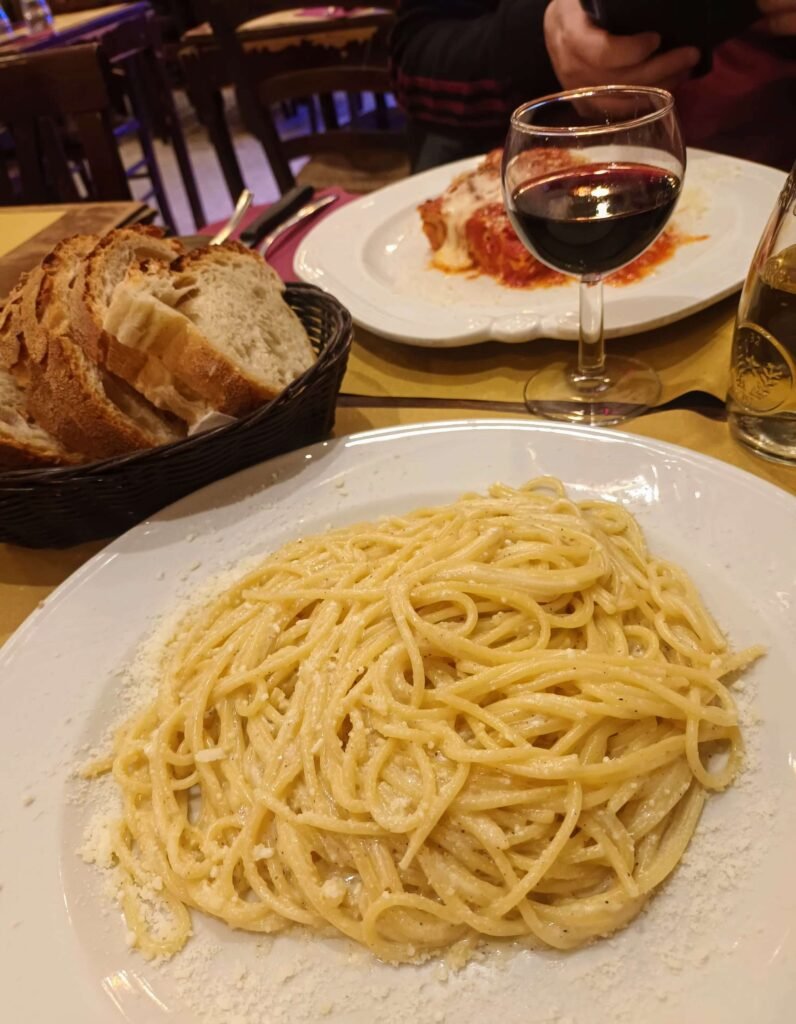
Campo de’ Fiori
After lunch, head to Piazza dei Fiori, a stunning piazza that is home to a bustling open-air food and flower market.
The translation of Campo de’ Fiori is ‘Field of Flowers,’ which just adds to the romantic charm of the city, and here you can purchase fresh pasta, olive oil, fruits, and vegetables.
In the middle of the piazza is a statue of the philosopher Giordano Bruno, who was burned here because he believed that the earth was round (in days gone by, the piazza held public executions).
Piazza Venezia
Next, head to Piazza Venezia to admire the breathtaking Altare della Patria, or Altar of the Fatherland, one of Rome’s most beautiful landmarks.
The Altar of the Fatherland, Tomb of the Unknown Soldier, or simply Il Vittoriano, is one of the most majestic buildings I’ve ever seen, and almost nobody talks about it!
This colossal white marble structure features an ever-burning flame, statues of the Goddess Roma and Vittorio Emanuele on horseback (the biggest statue in Rome!), and 14 female figures that represent different Italian cities.
You can climb the stairs and admire the statues for free, but you must pay 12 EUR to take the elevator right to the top.
When you’re finished, head back to your hotel for a quick rest and freshen up, because you’re about to cross the river and spend an evening in Trastevere.
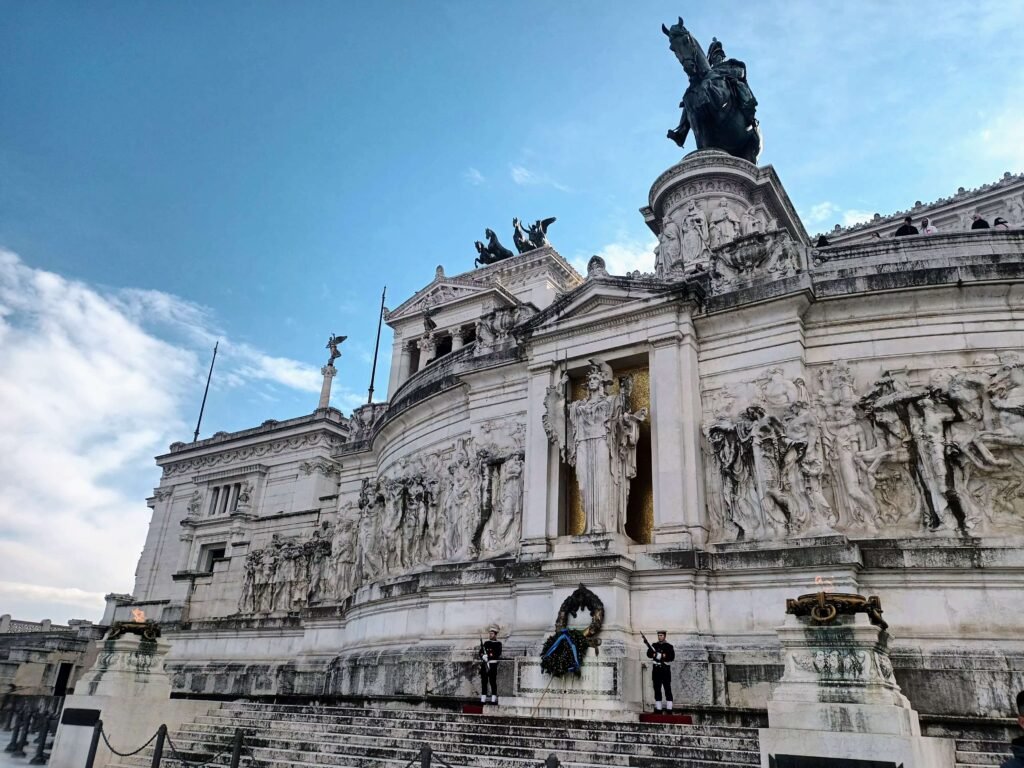
Dinner in Trastevere
Just across the Tiber River is Trastevere, a hipster Roman neighbourhood with tonnes of intimate restaurants, elegant enotecas, and grungy dive bars.
It’s a great place to spend an evening in Rome (if you only have one night in Rome, spend it here) and you’ll certainly pay less than if you dined out in the Historical Centre.
Head to Antica Osteria Rugantino, one of the best restaurants in Trastevere, for low lighting, delicious pasta, and great wine.
Myself and Ethan ordered a huge platter of 4 traditional Roman pastas from the ‘first course’ menu, and were too full to even contemplate getting a second course!
The cost of the pasta for 2 people, a bottle of wine, and bread, was 50 EUR.
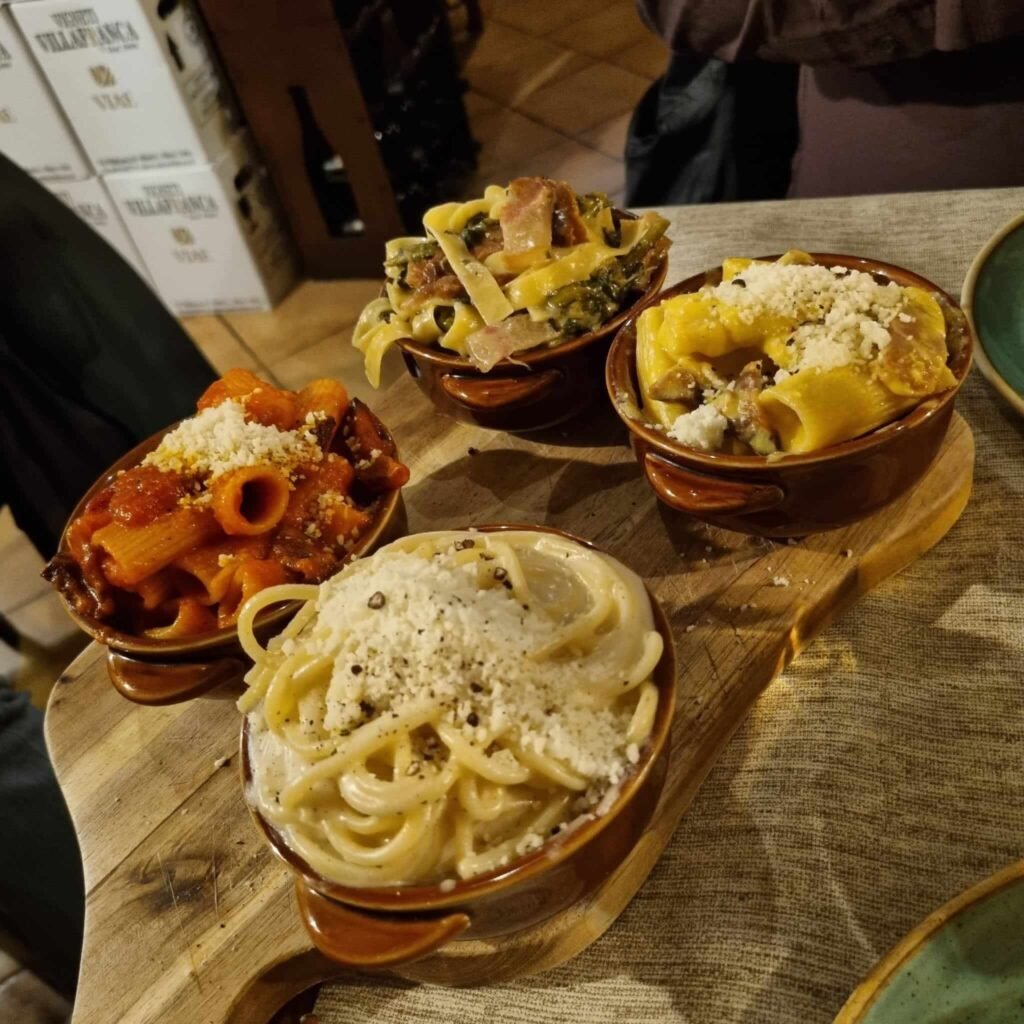
Big Hilda Public Bar
If you can still move after your meal, head to Big Hilda, a local’s favourite bar with great cocktails and a lively (but not too hectic) atmosphere.
Day 2 | Ancient Rome – Colosseum, Roman Forum, Palatine Hill, Baths of Caracalla, Mouth of Truth
The Colosseum
Your 3 days in Rome wouldn’t be complete without visiting Rome’s biggest and most important attraction – the Colosseum.
The Colosseum is one of the most famous monuments in the world, and provides a fascinating glimpse into life during the Roman Empire.
Built between 72 – 80 AD, the Colosseum would hold up to 50,000 people who would eat, drink, and gamble as they watched gladiators and exotic animals fighting each other to the death in the arena below.
Although this is certainly an interesting part of history, it is also tragic, as around 500,000 humans and 1,000,000 animals sadly lost their lives in the Colosseum.
As well as marvelling at the structure itself, the exhibition inside contains a plethora of ancient artefacts including animal skulls, coins, jewellery, sculptures, and more, along with very in-depth information.
how to visit the colosseum
You can visit the Colosseum independently, or as part of a guided tour.
As the Colosseum draws in significantly less crowds in the winter months, I’d recommend visiting independently during these months, as you will be able to take your time and read the exhibit.
I visited independently, and if you do this, you should still reserve your spot online first.
If you are visiting Rome in high or shoulder-season, it’s best to go with a guided tour.
A guided tour is the fastest way to get in, and your guide will be able to give you all of the most interesting information, so you can be sure to make the most of your visit.
Depending on the tour you book, you can also get exclusive access to restricted areas such as the Arena and Underground.
Tips for visiting the Colosseum without a guide:
– Buy your ticket in advance. If you’re visiting Rome in high-season, this means as early as you possibly can.
– Pay the extra couple of euros for fast track entry so that you can skip the line.
– Book the 9 am slot. It’s going to be a busy day!
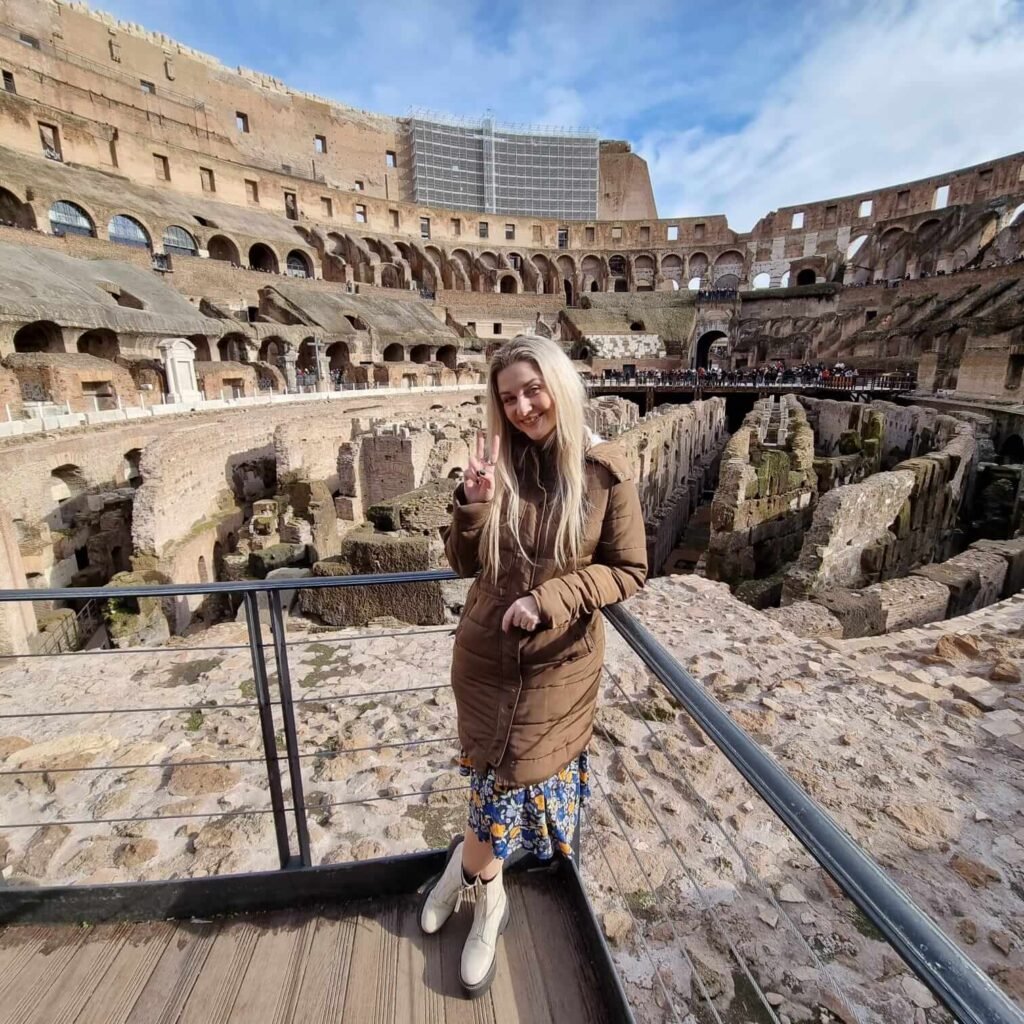
Roman Forum and Palatine Hill
Next on your 3 day Rome itinerary, you’ll head to the Roman Forum and Palatine Hill, two more major Rome attractions.
Entry to both is included with the price of your Colosseum ticket, and as they’re right next door, you’d be foolish for skipping them!
For centuries, Roman life revolved around this area, and it was a village, marketplace, business district, and more.
Not only can you see various archaeological excavations of old walls and roads, but there are also several ruined temples and shrines here.
Pro tip: don’t miss the Temple of Romulus, a well-preserved temple and museum with centuries old frescoes within the Roman Forum.
Palatine Hill is also home to many shrines and temples, but the main draw for tourists is the panoramic views of the Colosseum that it provides.
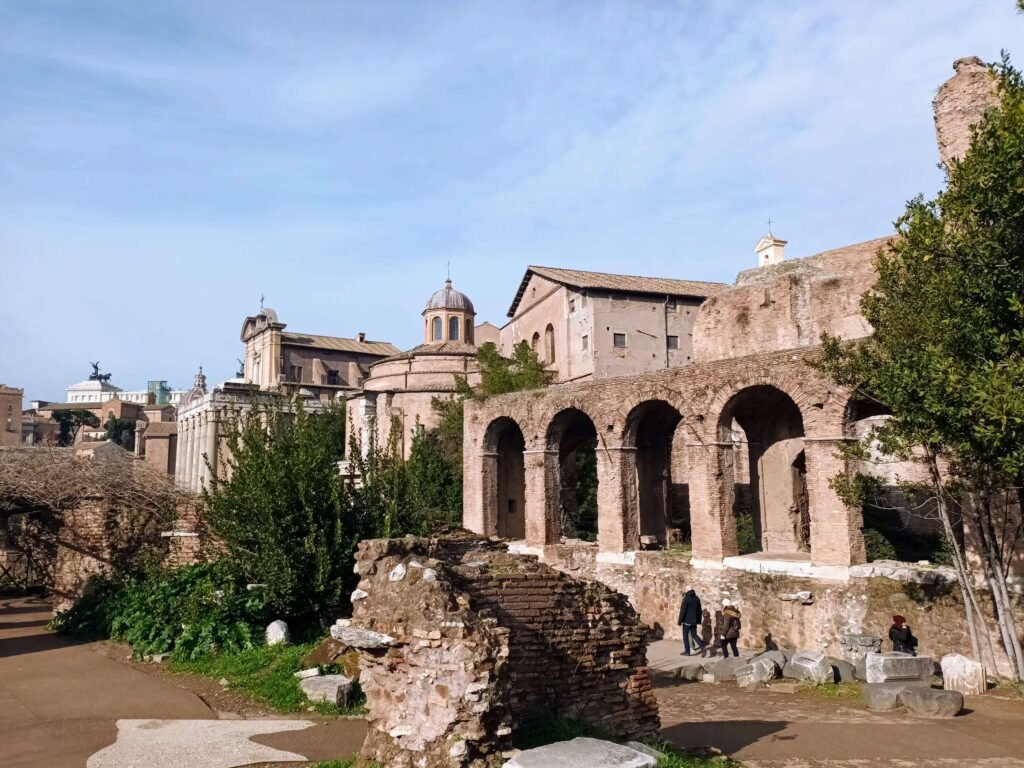
Lunch at Luzzi
By now, you’ve probably worked up an appetite, and while there are many tourist trap restaurants around the Colosseum, you can still get a decent meal here.
One of the best restaurants near the Colosseum is Pizzeria Luzzi (also called Trattoria Luzzi), and it was one of the few restaurants that had a queue in January (with an exclusively local clientele!).
As soon as our food arrived, we understood why this place was so popular.
We ordered tomato and mozzarella suppli (Rome’s answer to Sicilian arancine), Jewish-style artichokes, Amatriciana (pasta with guanciale, cured pork cheek) and tomato sauce), and Roman-style oxtail with tomato sauce.
All of this food, plus a LITRE of wine and bread, came to a grand total of 32 EUR.
Psst – if you want to know more about what to eat in Rome, read my post about Roman foods!
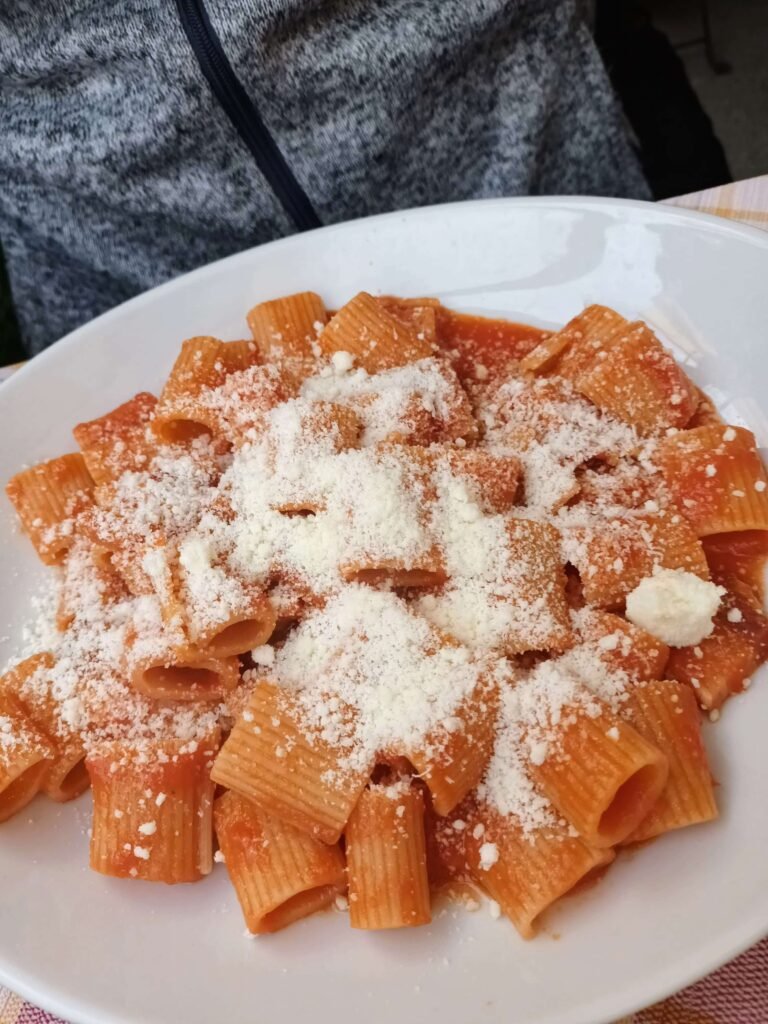
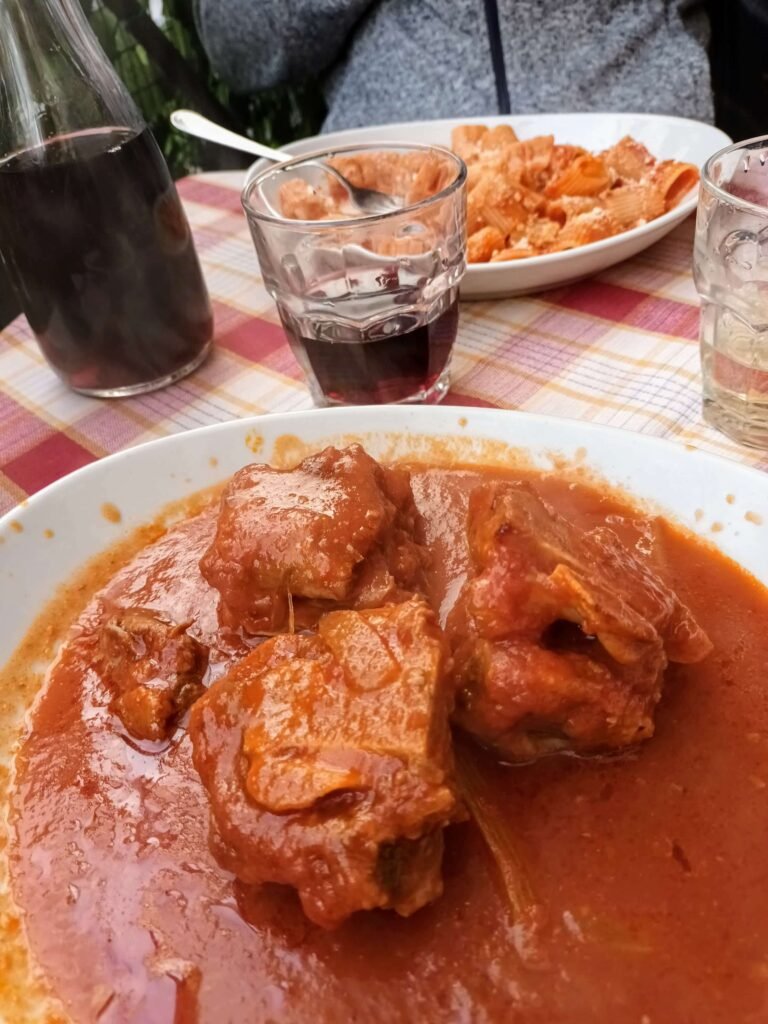
Baths of Caracalla
After lunch, take the short walk to the Terme di Caracalla, or Baths of Caracalla, ancient public baths that could accommodate up to 1600 bathers at once!
Not only did the stunning complex hold baths, but there were also gardens, libraries, and temples, and a visit to the baths was a way of socialising for over 300 years!
Wander through what remains and take in the sheer scale of them. You can even see areas of mosaic floor that still remain.
Entrance to the Baths of Caracalla is 8 EUR.
Mouth of Truth
The Mouth of Truth, or Bocca della Verita, is about 20 minutes on foot from the Baths of Caracalla, and is a huge stone face with an open mouth.
Legend has it that it bites the hands of liars, so a popular thing for tourists to do is place your hand inside and pose for a photo.
The Bocca della Verita is just outside the Santa Maria in Cosmedin church, which is also worth a visit.
An evening in Monti
To save your feet, spend your second night in Monti, a trendy bohemian neighbourhood close by that is full of jazz clubs, wine bars, mixology-bars-cum-art-galleries, and chic aperitivo joints.
Start your evening at Ai Tre Scalini, a candlelit wine bar with hundreds of Italian wines and a menu featuring Buffalo Ricotta drizzled with truffle honey, porchetta, and marinated Angus beef carpaccio.
When you’re finished, check out Charity Café Jazz & Blues Club, or The Fiddler’s Elbow, a cosy Irish pub with a great Guinness.
Day 3 | The Vatican – Vatican Museums, Sistine Chapel, St. Peter’s Basilica, Trastevere
The Vatican
As your 3 days in Rome are almost at an end, start your last day early with a guided tour of Vatican City, a country within the city of Rome.
A Vatican Museums guided tour is the best way to visit The Vatican, because not only will you learn so much more, but because tours also always get to skip the line.
All guided tours of the Vatican Museums include the famous Sistine Chapel, which took Michelangelo spent 4 years painting!
Vatican tours I recommend are this Vatican Museums, Sistine Chapel, and Basilica tour, which has over 36,000 positive reviews, or this Early Entrance Small Group Tour, which allows you exclusive early access to the Vatican Museums an hour before they open to the public and includes breakfast.
If you want to visit The Vatican without a tour, get this Vatican Fast-Entry Ticket to skip the line.
St. Peter’s Basilica
St. Peter’s Basilica is the largest church on earth, with the tallest Dome (you can actually climb the Dome and enjoy stunning views over Vatican City and Rome).
Entrance is free, but if you’ve opted for a tour that includes the basilica, you’ll get to skip the line and enter through a passageway that connects the Sistine Chapel with the basilica, saving 20 minutes of walking.
If you want to climb the Dome, you must pay a fee of 6 or 8 EUR (depending on how many stairs you want to climb!).
Top tip: The restaurants around The Vatican are notorious for scamming tourists. While you’ll definitely be hungry after your Vatican visit, don’t fall into the trap of eating here!
Trastevere
Head to Trastevere in the afternoon to explore this quirky district in daylight.
Wander the flower-lined cobblestone alleys, discover photogenic courtyards, buy some souvenirs from artisan shops, and stay here for the evening.
Make sure to visit Piazza di Santa Maria and Basilica di Santa Maria, as it’s one of the prettiest churches in Trastevere.
The Basilica di Santa Maria dates back to the 3rd century and inside, you’ll find opulent gold ceilings, 12th century mosaics and frescoes, and lots of beautiful paintings.
Entrance to the Basilica is free.
Begin your night at Bar San Calisto for the cheapest Aperol Spritz in Rome (and possibly the most outdated interior), before heading to one of the many fantastic Trastevere restaurants for dinner.
We had a great (but ‘interesting’) meal at Papa Re, with the total bill being less than 50 EUR for one pasta dish to share, 2 mains, 2 desserts, and at least 1.5 litres of wine!
Other great Trastevere restaurants include Trattoria Da Enzo al 29, Trattoria Da Teo, Le Mani in Pasta, and Tonnarello.
Finally, head to the grungy Mr Brown Pub for homemade vodka, cold beer, and a great vibe.
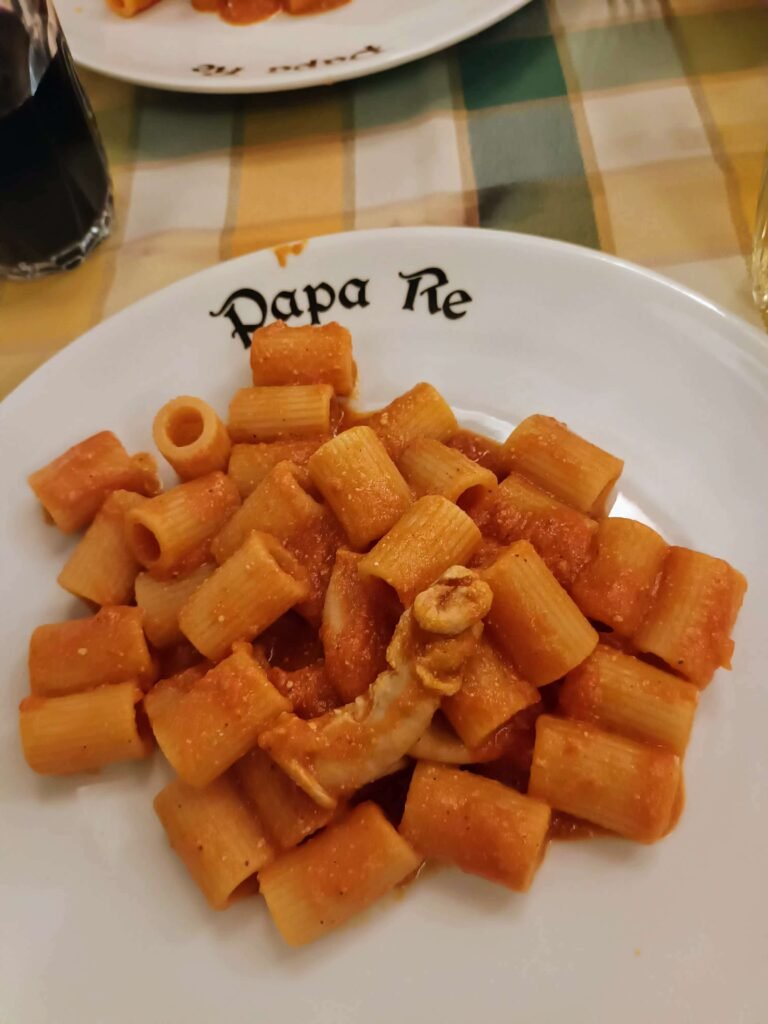

Best time to visit Rome
The summer months of July and August are when most people visit Rome, but if you’ve ever traipsed through an Italian city during summertime, you’ll know that it’s a really bad idea.
With sweltering heat, overwhelming crowds, inflated prices, pickpockets, and tourist traps galore, not to mention many restaurants and bars being closed for the season, cities like Rome can be pretty unforgiving in high season.
Shoulder season (September/October) is when the crowds begin to thin out a bit and prices of accommodation comes down, but if you ask me, the best time to visit Rome is in the winter.
The temperatures are certainly on the colder side, but when I spent 3 days in Rome in January, I got to enjoy the city almost to myself, never had to wait in line, and saw a side to the city that few people ever get to experience.
I wrote a whole guide to visiting Rome in the winter here if you’re interested.
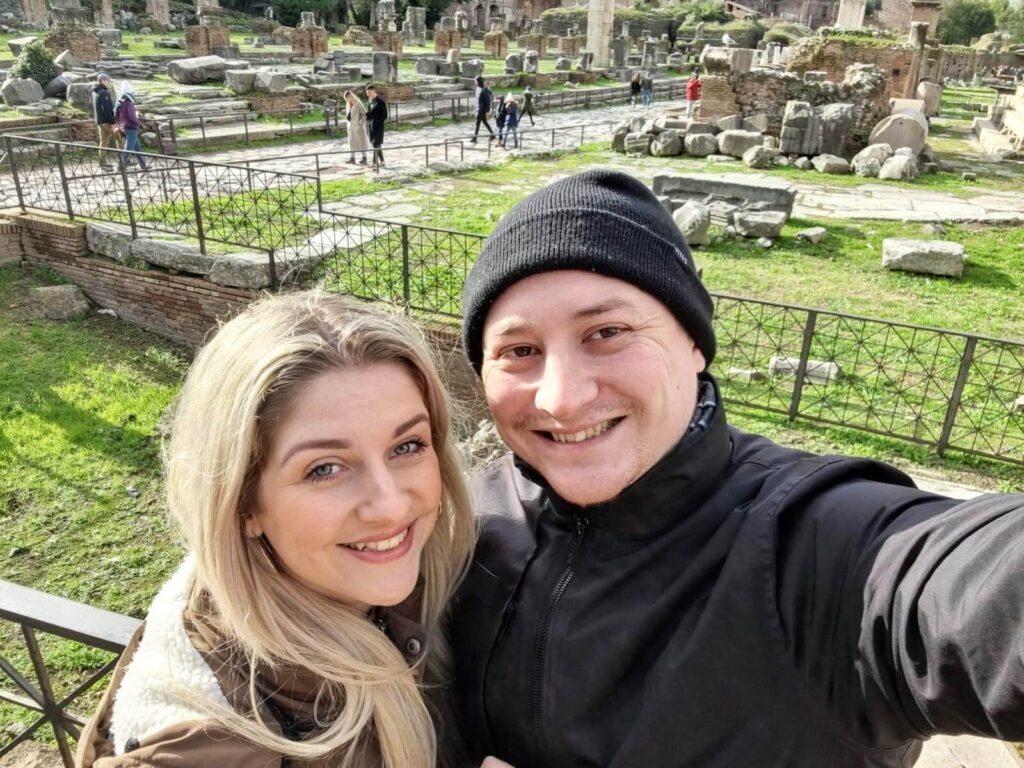
Rome packing list
Of course, what you need to pack for Rome will depend on what time of year you visit.
Italy has 4 distinct seasons, and temperatures in Rome can range from almost freezing to oppressively hot.
With that being said, there are some things that are essential for any visit to Rome.
Here are my recommendations:
– Comfortable walking shoes (I cannot stress this enough) and maybe even gel foot cushions or soft insoles
– Plasters (for blisters!)
– Travel adaptor
– Reusable water bottle (tap water in Italy is safe to drink, and there are public drinking fountains everywhere)
– Travel scarf or pashmina (Italians have a firm belief in keeping your neck warm so will often wear scarves all year round!)
– Powerbank
I would also advise you to pack nice clothes for Rome, especially for the evening.
Italians are very fashion-conscious, and would never wear jogging bottoms out of the house, leggings as pants, activewear when not working out, and those hideous t-shirts with pictures of the Colosseum on.
If you want to fit in, dress how you’d dress if you were dining out at a nice restaurant at home (yes, even when sightseeing!).

How to get around Rome
I walked everywhere in Rome, and aside from The Vatican, things are not too far apart from each other.
The longest walk that I took during my 3 days in Rome was from my hotel to Trastevere, which was about 25 minutes.
The problem is that those 10, 15, and 25 minute stretches start to add up, and you can easily clock up 20,000 steps per day!
If you don’t want to walk everywhere, the metro system in Rome is fantastic (you can take the metro to The Vatican), and there are buses too.
If you want to take a taxi, you can use Uber or the FREE NOW taxi app for the best price (the few taxis that we took were not expensive). I don’t recommend flagging down a taxi in the street or using a taxi rank.
Where to stay during your 3 days in Rome
The 3 best areas in Rome to stay in are Centro Storico, Monti, and Trastevere.
Centro Storico
This is the medieval part of Rome that is home to most of Rome’s major landmarks. Expect upscale hotels, Renaissance architecture, and more tourists.
Monti
Monti is a cool neighbourhood with lots of cocktail and wine bars, a vibrant atmosphere, and a great location close to the Colosseum, Roman Forum, and Palatine Hill.
Trastevere
Trastevere is a little further away and across the river, but is where you’ll find a labyrinth of cobbled streets, bohemian coffee shops and bars, and a more authentic feel.
Where I stayed
We stayed in Hotel Forum Roma, a grand 4-star hotel situated between the Colosseum and Piazza Venezia.
This 18th century building has an opulent feel (think wainscot panelling, parquet floors, Persian rugs and gold silk sheets), with a rooftop bar and restaurant offering stunning views, and former guests including the Dalai Lama and Gregory Peck.
It’s also within walking distance of Roma Termini station, making it very convenient to reach from the airport.
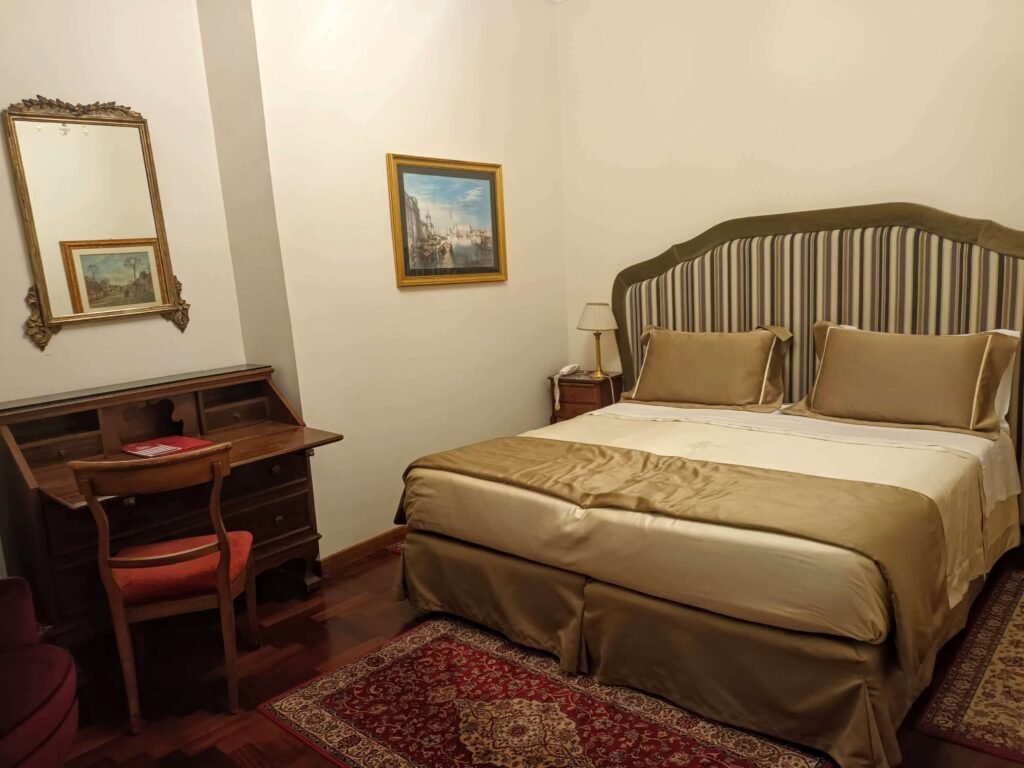
Is Rome safe?
Many visitors to Rome worry whether Rome is safe, and I get it.
Rome is one of the most popular tourist destinations in all of Europe, and wherever you have tourists, you also have pickpockets (to be fair, wherever you have people, you have pickpockets, but you get what I’m saying).
High season is especially rife with touts trying to scam you, and this is also when the pickpockets are out in force.
As you would anywhere, stay vigilant and keep a tight hold of your belongings.
There is a high police presence in Rome, and you are never far away from a police/security/military person who can come to your aid if needed.
Like any city, Rome has some areas that should be avoided, but they are residential neighbourhoods and not somewhere you’d visit as a tourist anyway (you’d have to seriously be lost to end up in one!).
As always, areas around the train stations can be a bit rough, so keep a tighter hold on your phone and purse here.
3 Days in Rome | Final Thoughts
Although 3 days in Rome is definitely not enough to see everything, you can still get a fair amount done with some forward planning.
Rome is an absolutely magical city that everybody should visit at least once, and I will definitely be back to discover more of it.
That’s about it for now, but as always, if you have any questions, don’t hesitate to ask me in the comments section below!
Until next time,
XOXO
If you liked this article and would like to support my work, please click the button above to donate a couple of bucks and buy me a coffee. The ad revenue that I receive on this website is minimal, so support from my readers enables me to keep creating content that you (hopefully!) love to read.

If you know the day and time you want to visit the Vatican Museum you can go to the Vatican Museum website and purchase your tickets (22 euros). At the chosen time you can go to the front of the line and get right in. The last Sunday of the month it is free (but extra crowded). My first time in Rome was 7 days and the second time was six days. Even that was not enough to see everything I wanted to see (I’m a history nut).
Thanks so much for your comment!